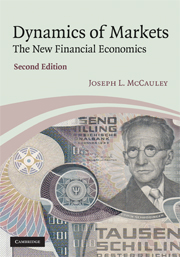Book contents
- Frontmatter
- Contents
- Preface to the second edition
- 1 Econophysics: why and what
- 2 Neo-classical economic theory
- 3 Probability and stochastic processes
- 4 Introduction to financial economics
- 5 Introduction to portfolio selection theory
- 6 Scaling, pair correlations, and conditional densities
- 7 Statistical ensembles: deducing dynamics from time series
- 8 Martingale option pricing
- 9 FX market globalization: evolution of the Dollar to worldwide reserve currency
- 10 Macroeconomics and econometrics: regression models vs empirically based modeling
- 11 Complexity
- References
- Index
Preface to the second edition
Published online by Cambridge University Press: 02 December 2010
- Frontmatter
- Contents
- Preface to the second edition
- 1 Econophysics: why and what
- 2 Neo-classical economic theory
- 3 Probability and stochastic processes
- 4 Introduction to financial economics
- 5 Introduction to portfolio selection theory
- 6 Scaling, pair correlations, and conditional densities
- 7 Statistical ensembles: deducing dynamics from time series
- 8 Martingale option pricing
- 9 FX market globalization: evolution of the Dollar to worldwide reserve currency
- 10 Macroeconomics and econometrics: regression models vs empirically based modeling
- 11 Complexity
- References
- Index
Summary
This book provides a thorough introduction to econophysics and finance market theory, and leads the reader from the basics to the frontiers of research. These are good times for econophysics with emphasis on market instability, and bad times for the standard economic theory that teaches stable equilibrium of markets. I now explain how the new volume differs in detail from the first edition.
The first edition of Dynamics of Markets (2004) was based largely on our discovery of diffusive dynamics of the exponential model, and more generally on the dynamics of Markovian models with variable diffusion coefficients. Since that time, the progress by the University of Houston Group (Kevin Bassler, Gemunu Gunaratne, and me) has produced a far more advanced market dynamics theory based on our initial discovery. The present book includes our discoveries since 2004. In particular, we've understood the limitations of scaling and one-point densities: given a scaling process, only the one-point density can scale, the transition density and all higher-order densities do not and cannot scale, and a one-point density (as Hänggi and Thomas pointed out over 30 years ago) cannot be used to identify an underlying stochastic process. Even pair correlations do not scale. It follows that scaling cannot be used to determine the dynamics that generated a time series. In particular, scaling is not an indication of long time correlations, and we exhibit scaling Markov models to illustrate that point.
- Type
- Chapter
- Information
- Dynamics of MarketsThe New Financial Economics, pp. xi - xviPublisher: Cambridge University PressPrint publication year: 2009



